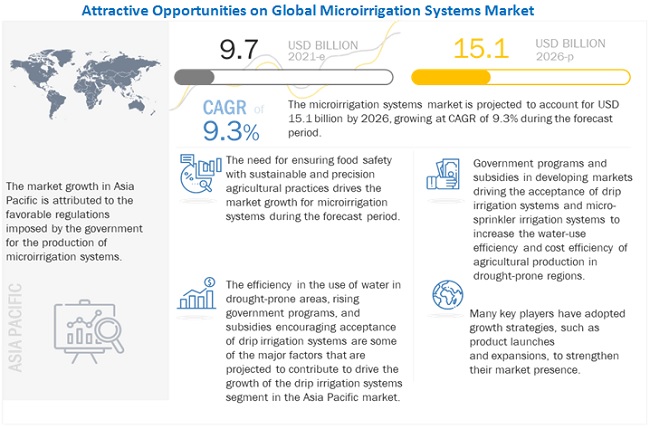The global microirrigation systems market size is estimated to be valued at USD 9.7 billion in 2021 and is expected to reach a value of USD 15.1 billion by 2026, growing at a CAGR of 9.3% in terms of value during the forecast period. Factors such as the increase in awareness among farmers about the benefits of microirrigation and the importance of conserving water are the key factor driving the growth of the microirrigation systems market. Microirrigation systems provide a highly efficient means to sustain water supply and enhance the productivity of farms. These systems are widely used across the world to safeguard crops during drought spells. These are some of the factors driving the growth of the microirrigation systems market during the forecast period.
Download PDF brochure: https://www.marketsandmarkets.com/pdfdownloadNew.asp?id=566

The demand for microirrigation has been witnessing a steady growth in developing countries, such as China, Brazil, South Africa, Russia, and India. These countries have the largest population and an increase in demand for food grains are some of the major key factors that would drive the microirrigation market in these regions. In the developed markets, the growers have been establishing innovative irrigation technology platforms for their large-scale farming activities to improve the crop yield and increase their returns. This sustained approach from developed and developing countries in agriculture has been driving the global microirrigation market. Key advancements in the microirrigation market include the introduction of pressure compensating systems, which have helped improve system compatibility in uneven terrains. The prospect of fertigation has also helped improve the acceptance for microirrigation systems, as they integrate the use of fertilizers during irrigation, thereby minimizing leaching and improving yields.
According to the United Nations World Water Development Report 2019, agriculture constitutes 69% freshwater withdrawal (water taken from ground or surface water source temporarily or permanently), globally. The globalization has resulted in a decrease in the availability of natural resources, such as land and water. The growing population has also encouraged the need to improve agricultural productivity, which has resulted in the need for sustainable agriculture, of which microirrigation plays a major part. Microirrigation systems have enabled the use of undulating land, rolling topography, and barren land for cultivation, which has also led to an increase in area under horticultural crops, government support, multiple manufacturers, as well as yield that has driven the growth of the drip irrigation market. According to the United Nations World Water Development Report 2019, nearly 80% of the global cropland is rain-fed and 60% of the world’s food is produced on rain-fed land, which contributes to the high rates of freshwater withdrawal.
Microirrigation systems are substances that contain living microorganisms or latent cells. Microirrigation systems are made from biological wastes and do not contain any chemicals.The National Center of Organic Farming (NCOF) defines microirrigation systems as “products containing carrier-based (solid or liquid) living microorganisms, which are agriculturally useful in terms of nitrogen fixation, phosphorus solubilization, or nutrient mobilization, to increase the productivity of the soil and/or crop.
Make an Inquiry: https://www.marketsandmarkets.com/Enquiry_Before_BuyingNew.asp?id=566
The increase in demand for microirrigation systems in agricultural irrigation, landscape irrigation, and greenhouse irrigation, is driven mainly due to the water scarcity and economic expansion in developing countries. The demand in developed nations is driven primarily by newly developed technology profiles and the increase in convenience they offer to farmers. The demand for microirrigation systems is growing rapidly in the world’s most populous developing countries, namely, India and China. These countries are facing a shortage of agricultural water and are under pressure to increase their productivity with the available arable land. Extensive changes in climate have encouraged farmers in developing countries of the Asia Pacific region to use microirrigation systems.
